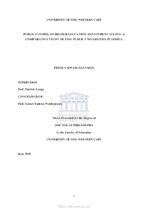| dc.contributor.advisor | Langa, Patrício | |
| dc.contributor.advisor | Woldegiorgis, Emnet Tadesse | |
| dc.contributor.author | Kwasi-Agyeman, Fredua | |
| dc.date.accessioned | 2021-02-16T07:56:53Z | |
| dc.date.available | 2021-02-16T07:56:53Z | |
| dc.date.issued | 2020 | |
| dc.identifier.uri | http://hdl.handle.net/11394/7824 | |
| dc.description | Doctor Educationis | en_US |
| dc.description.abstract | This study examines changes in public funding and student access, factors influencing the
changes in public funding, and strategic responses towards influencing variations in student
access under fluctuations in public funding at two African public universities, the University
of the Western Cape in South Africa and the University of Ghana in Ghana. Underpinned by
resource dependence theory, the study uses a qualitative methodology via in-depth
interviewing of twenty-two respondents and documentary analysis to gather data to explore the
study’s objective. The public funding of higher education and student access in South Africa
and Ghana have been changing over time, where various issues of concern have been raised
about the changes. This study explores the relationship between changes in public funding and
student access at both universities.
The study finds that the levels of change in public funding have a significant effect on the
variations in student access at the University of the Western Cape. In other words, changes in
public funding are a major factor in changing student access. The analysis shows that,
statistically, approximately 94 percent of the variation in student enrolment between 2007 and
2016 is accounted for by public funding. However, the study finds an insignificant relationship
between changes in public funding and student access at the University of Ghana.
The findings reveal that the state of the economy; competing needs of the various sectors; low
prioritization of higher education; sectoral planning and budgeting; a shift of focus from
education; funding mechanism; and overspending in election years are factors that influence
changes in public funding at both institutions. Strategic responses such as government subsidy;
low-tuition fee structure; payment arrangement; recruitment strategy; containment strategy;
special grants; financial support system; policy for the admission of athlete students; and policy
for less-endowed schools have been employed by the two universities to influence variations
in student access in the face of fluctuations in public funding.
The study concludes by generating practical and conventional propositions on public funding
of higher education and student access. A recommendation for further research into changes in
public funding and student access is also suggested. A similar study could thus be undertaken
to investigate the relationship between changes in tuition fees and student access. | en_US |
| dc.language.iso | en | en_US |
| dc.publisher | University of Western Cape | en_US |
| dc.subject | Public funding | en_US |
| dc.subject | Higher education | en_US |
| dc.subject | Africa | en_US |
| dc.subject | Universities | en_US |
| dc.subject | Student experience | en_US |
| dc.subject | Student access | en_US |
| dc.subject | University of Ghana | en_US |
| dc.subject | University of the Western Cape | en_US |
| dc.subject | Ghana | en_US |
| dc.subject | South Africa | en_US |
| dc.title | Public funding of higher education and student access: A comparative study of two public universities in Africa | en_US |
| dc.rights.holder | University of Western Cape | en_US |

